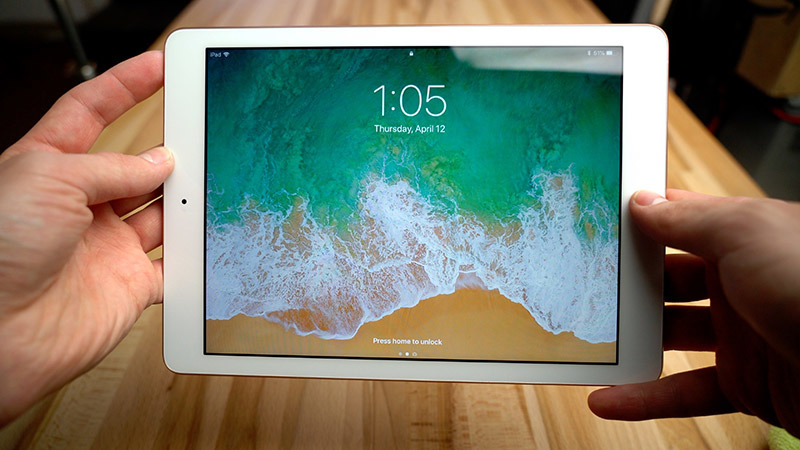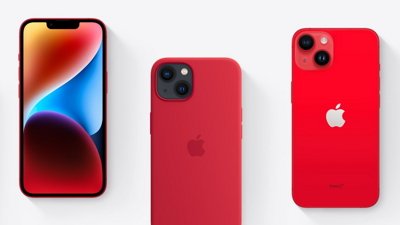Apple's new 2018 iPad is undoubtedly the budget iPad of choice, thanks to it's powerful A10 Fusion processor and Apple Pencil support, which until now, hasn't been available on any iPad other than the Pro line. However, the low-cost build creates some pretty big issues that might make you reconsider.
Non-Laminated display
The first issue with the new iPad, which we reviewed in-depth this month, is that it comes with a non-laminated display. The decision to use this sort of screen means there's more glass between the display panel and the cover surface, creating a noticeable and annoying gap around the screen edge.
The iPad Pro's laminated screen has an extremely small gap which is less distracting, while also making it feel like the display is almost sitting on top of the glass.
When you use Apple Pencil, one of the highlight additions to the new iPad, the experience is less impressive when compared to the iPad Pro. The gap is quite noticeable, with the effect of writing above the surface of the display potentially affecting accuracy when creating detailed drawings or when handwriting notes.
The 2018 iPad also has an odd hollow feel when you tap the screen, unlike the solid and well-built feel of the iPad Pro. You can even hear the difference between the two screens when tapping them.
Not only that, but laminated displays are also able to show deeper black shades than the non-laminated versions. By comparison, dark hues look gray on the 2018 iPad's display.
Even though we think it's worth replacing your old iPad with the 2018 iPad because of the processor improvements and Apple Pencil support, both the iPad Mini 4 and iPad Air 2 have laminated displays, making it tough to go back to a non-laminated display after using those models.
No Anti-Reflective Coating
The 2018 iPad's display is distractingly reflective. Every iPad that that comes with a laminated display also gets an anti-reflective coating, but since the 2018 is not laminated, it doesn't receive this extra treatment during production.
We didn't think it was a big deal until we actually started using both the new iPad and the iPad Pro at the same time. Even using them indoors, we could still see a huge difference in reflectiveness.
Taking the two tablets outside, reflections on the new iPad were even more distracting, forcing us to set the brightness to the maximum to see what was onscreen, even on an overcast day. By contrast, the iPad Pro was less reflective in tests, even at lower brightness.
Because the anti-reflective coating cuts down on glare, iPad Pro users don't need to crank up brightness, equating to potential battery life savings even when outdoors.
Old Touch ID Technology
Another issue with the new iPad is that it still uses Apple's first-generation Touch ID. The iPhone line and current iPad Pro models have moved on to the second-generation version, yet the iPad sticks with the first.
Even before comparing it against the version used on the new iPad Pro, we noticed it was fairly slow and not very reliable.
Since the second-generation of Touch ID was introduced with the iPhone 6S, most iPhone users will probably notice the difference, unless they're using an iPhone 6 or iPhone 5S.
The iPad's Touch ID sensor can be tapped repeatedly without unlocking, due to its slowness, and won't unlock unless you rest your finger on it for an extended period. On the iPad Pro, Touch ID is so fast that it unlocks while pressing the home button to wake the screen.
Just using the power button to try out the same tap test on the iPad, it is lightning fast to lock and unlock. When compared side-by-side, the faster Touch ID unlocking offered by the iPad Pro provides an enhanced sense of reliability compared to the newer iPad.
Old Selfie camera
The FaceTime selfie camera mounted on iPad's front fascia continues to be an issue, with the latest version using an absolutely awful 1.2-megapixel sensor capable of recording a meager 720p video.
This is effectively the same FaceTime camera that came with the fourth-generation iPad from 2012. It's the year 2018, six years later, and it's shocking that we still have devices like these that are limited to 720P recording.
The iPad Pro comes with a 7-megapixel FaceTime camera capable of recording in 1080p. While it may not seem like a big difference, it actually is an important upgrade due to the 1080p resolution using more than double the number of pixels as a 720p image.
It's a huge disappointment that Apple continues to use such a low-resolution selfie camera that hasn't seen any major change in so many years.
Old Display Technology
The last issue also relates to the display, specifically about the technology used to render an image. The new iPad is still using the same old Retina display that Apple introduced with the 3rd-generation iPad in 2012.
Many of Apple's latest products are now being equipped with displays that support P3 wide-color gamut, which produces more vibrant and accurate colors. On the iPhone side, the iPhone X has moved on to a better OLED display compared to its predecessors, and it's quite likely OLED-equipped iPad Pro models will make an appearance in the near future.
Even Samsung's Galaxy Tab S2 has a Super AMOLED display, and that tablet dates back to 2015.
It's extremely disappointing that the new iPad is effectively stuck with a 6-year-old display, instead of progressing to newer display technologies.
The 2017 iPad Pro also has ProMotion, which allows the screen to increase its refresh rate to a maximum of 120Hz, double the refresh rate of the 2018 iPad. ProMotion's higher refresh rate makes the overall experience more fluid, and it dramatically reduces input lag while using the Apple Pencil, bringing drawing on the screen even closer to how it would feel to use pen and paper.
Even though the 2018 iPad gets an extremely powerful processor and Apple Pencil support, and we definitely recommend buying it, the lacking display, slow Touch ID, and woeful front-facing camera makes it feel like an older iPad model.
Nobody wants to feel stuck in the past, especially in 2018, but in some ways, the iPad still is.
 AppleInsider Staff
AppleInsider Staff












-m.jpg)






 Marko Zivkovic
Marko Zivkovic
 Wesley Hilliard
Wesley Hilliard
 Christine McKee
Christine McKee


 Malcolm Owen
Malcolm Owen
 William Gallagher
William Gallagher
 Andrew O'Hara
Andrew O'Hara






76 Comments
Well, I guess there is a reason why it costs half as much?
Apparently Apple Insider doesn't grasp the concept of low cost.
Are the squinty selphie pictures reversed? The 2018 picture looks more detailed to me.
Are the problems nonexistent in the 2017 iPad?
My gripe with the 2018 iPad is that it is not the iPad Pro.
Future article:
My gripe with the iPad Pro 2018 is that it costs double the iPad.